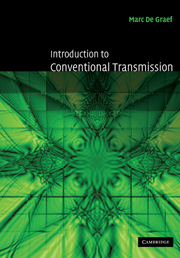Book contents
- Frontmatter
- Contents
- Preface
- Acknowledgements
- Figure reproductions
- 1 Basic crystallography
- 2 Basic quantum mechanics, Bragg's Law and other tools
- 3 The transmission electron microscope
- 4 Getting started
- 5 Dynamical electron scattering in perfect crystals
- 6 Two-beam theory in defect-free crystals
- 7 Systematic row and zone axis orientations
- 8 Defects in crystals
- 9 Electron diffraction patterns
- 10 Phase contrast microscopy
- Appendix A1 Explicit crystallographic equations
- Appendix A2 Physical constants
- Appendix A3 Space group encoding and other software
- Appendix A4 Point groups and space groups
- List of symbols
- Bibliography
- Index
2 - Basic quantum mechanics, Bragg's Law and other tools
Published online by Cambridge University Press: 02 December 2009
- Frontmatter
- Contents
- Preface
- Acknowledgements
- Figure reproductions
- 1 Basic crystallography
- 2 Basic quantum mechanics, Bragg's Law and other tools
- 3 The transmission electron microscope
- 4 Getting started
- 5 Dynamical electron scattering in perfect crystals
- 6 Two-beam theory in defect-free crystals
- 7 Systematic row and zone axis orientations
- 8 Defects in crystals
- 9 Electron diffraction patterns
- 10 Phase contrast microscopy
- Appendix A1 Explicit crystallographic equations
- Appendix A2 Physical constants
- Appendix A3 Space group encoding and other software
- Appendix A4 Point groups and space groups
- List of symbols
- Bibliography
- Index
Summary
Introduction
One of the principal goals of transmission electron microscopy (TEM) is to observe and determine the crystallographic nature of a variety of features in materials, from the actual crystal structure to the detailed atomic configurations and chemistry around defects. In the previous chapter, we introduced the mathematical tools needed to describe crystal structures and to perform geometric computations in an arbitrary Bravais lattice. In the present chapter, we introduce another set of tools that are used to describe the interactions between electrons and the specimen.
Since observation of a phenomenon or an object always implies an interaction between the observer and that object, it is important that such observations be carried out under the proper conditions. For instance, to determine the color of an object, we would typically illuminate the object with white light, and analyze the frequencies of the reflected light, while to determine the fluorescent properties of that same object we would illuminate it with ultraviolet light, and so on. Establishing the proper observation conditions is thus crucial to the subsequent success of the observation. Since the object modifies the incident illumination, we can extract valuable information about the object by carefully analyzing this modified signal.
To determine the crystallographic characteristics of a material, we illuminate it with electrons. It is thus intuitively clear that the TEM must consist of three major stages:
(i) the illumination stage, which creates a beam of electrons in a well-defined reference state;
(ii) the interaction stage, where the sample modifies the reference state of the electron beam; and
[…]
- Type
- Chapter
- Information
- Publisher: Cambridge University PressPrint publication year: 2003



